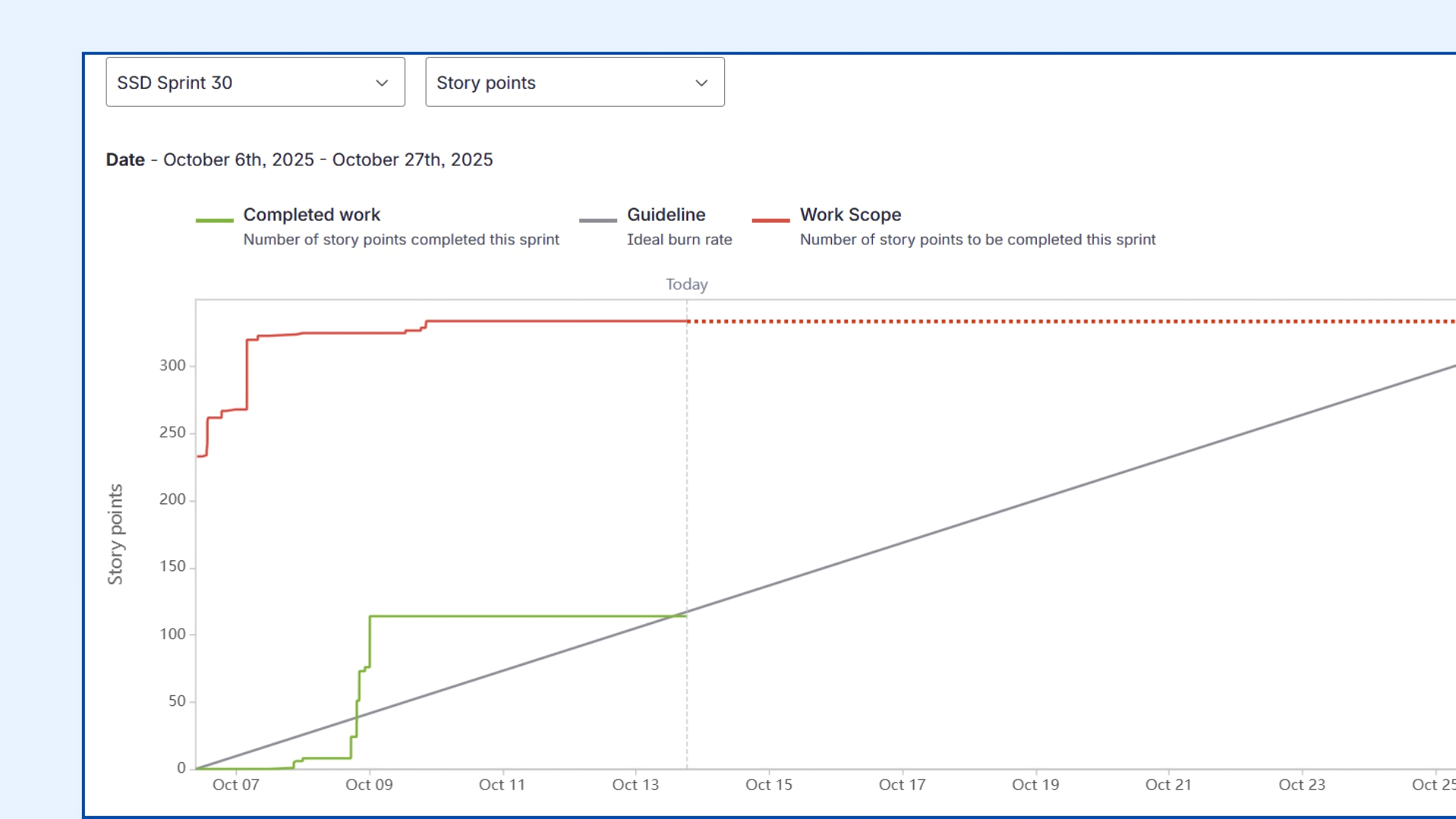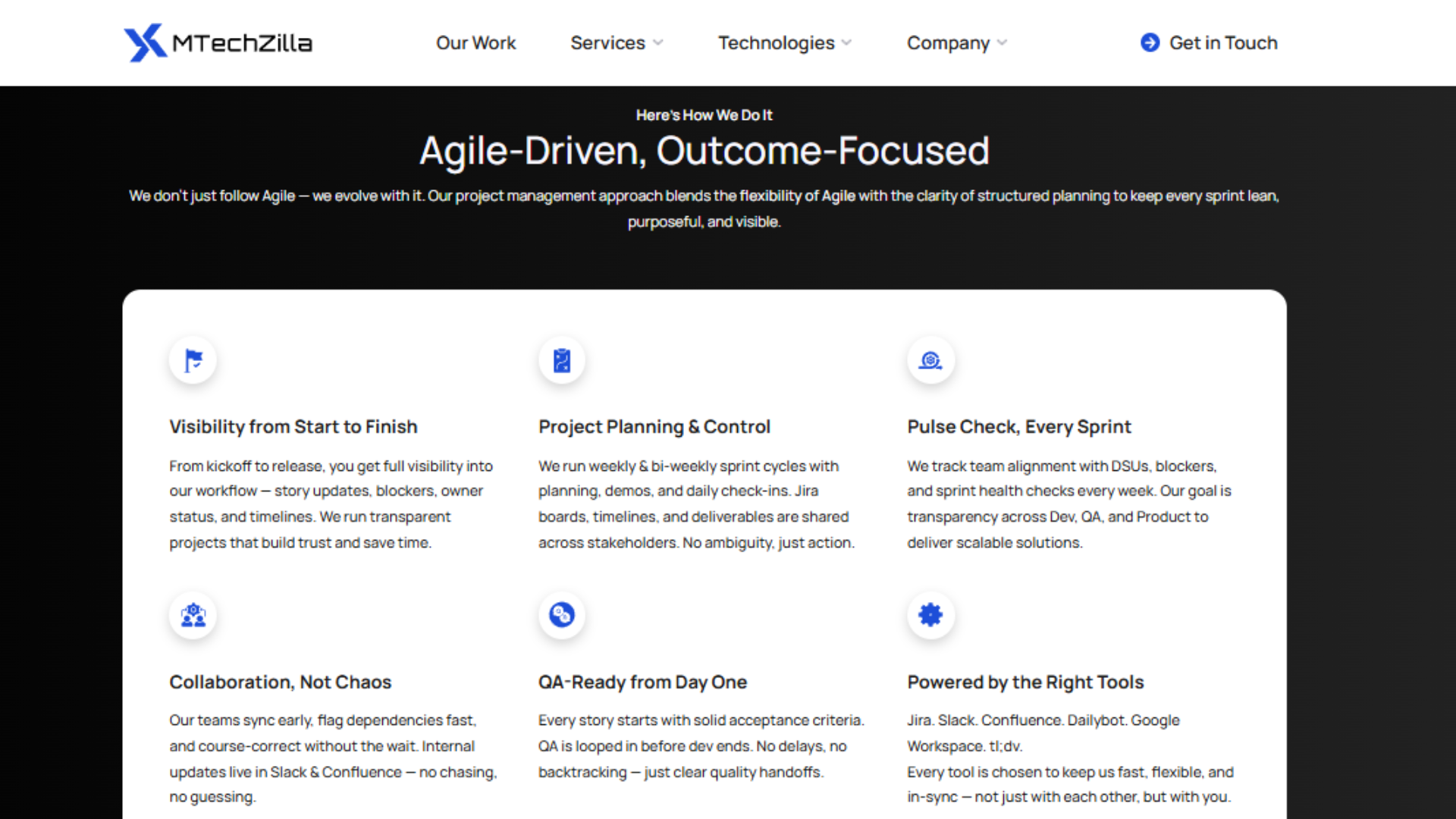October 13, 2025
12 min read

In 2025, software development teams, whether operating remotely, in hybrid setups, or on-site, face increasing pressure to deliver predictable results sprint after sprint.
Clients and stakeholders expect not just functional software but solutions that are secure, scalable, and aligned with business goals. Meeting these expectations requires more than technical expertise; it demands a disciplined and well-structured Software Development Lifecycle (SDLC) that ensures consistent quality and collaboration across teams.
To achieve this, many organizations continue to adopt or refine frameworks such as Agile, DevOps, and Lean. The outcomes are clear: improved code quality, higher productivity, better team alignment, and faster response to change.
This blog explores the top 10 Software Development Lifecycle (SDLC) best practices for 2025 and highlights the actionable approaches MTechZilla follows within its development teams to deliver faster results for clients.
Introduction
What is the Software Development Lifecycle (SDLC)?
Key Phases in the Software Development Lifecycle (SDLC) Process
What Are the Top 10 Software Development Lifecycle (SDLC) Best Practices (2025)?
Software Development Lifecycle (SDLC) Best Practices with MTechZilla
Frequently Asked Questions
The Software Development Lifecycle (SDLC) is the step-by-step process that software teams follow to build and deliver applications. It defines how an idea moves from concept to a working solution - covering planning, design, development, testing, deployment, and ongoing maintenance.
In simple terms, the SDLC keeps software projects structured and predictable. It helps teams know what to do, when to do it, and who is responsible at each stage. Different organizations use different frameworks to manage this cycle. Agile is common among teams that release features in short sprints.
A well-implemented SDLC brings structure, transparency, and accountability to each project, helping teams avoid costly errors and stay on time and within budget.
The Software Development Lifecycle (SDLC) defines how a software product moves from an idea to a fully deployed and maintained solution. While the exact structure may vary across organizations, most SDLC models include the following core phases:
Every successful project starts with clarity. In this phase, the software development team, including product managers, developers, designers, and business analysts, defines the project goals, target audience, core features, and technical requirements.
The team identifies risks, sets priorities, estimates timelines, and aligns on budgets. This step ensures everyone agrees on what is being built, why it matters, and how it will be delivered.
Key output: A clear project roadmap and documented requirements.
Once requirements are set, architects and designers translate them into a technical blueprint. This includes system architecture, technology stack, database design, and user interface structure. The design phase bridges business expectations with technical execution.
Key output: Wireframes, architecture diagrams, and design specifications ready for development.
This is where ideas turn into code. Developers build features, write integrations, and implement business logic based on the approved design. Teams use version control systems like Git and follow methodologies such as Agile or DevOps to ensure collaboration and progress tracking.
Key output: Working code modules that align with functional and technical requirements.
Quality assurance (QA) teams validate that the developed software works as intended. This includes functional, integration, performance, and security testing. Automated testing tools are increasingly used to speed up validation and detect issues early.
Key output: Tested and verified product ready for deployment.
Once the software passes testing, it’s released to a live environment. DevOps engineers handle this phase using CI/CD pipelines for smooth, error-free deployment. Depending on the project type, releases can be gradual (staged rollout) or complete.
Key output: Production-ready application available to end users.
After deployment, the software enters the maintenance phase. Teams monitor performance, fix bugs, release updates, and improve features based on user feedback. In modern workflows, this phase never really ends - it becomes part of a continuous improvement cycle.
Key output: Stable, secure, and up-to-date software that evolves with business needs.
The SDLC ensures organised, predictable, and outcome-driven development. Each phase builds on the last, helping teams deliver quality software on time while minimising rework and complexity.
Let’s quickly move on to the best practices of the Software Development Lifecycle (SDLC) in the following section.
Below are the top 10 Software Development Lifecycle (SDLC) best practices your development team should follow to ensure consistent delivery, quality, and collaboration across every stage of the process.
Integrate Generative AI Across the Software Development Lifecycle
Adopt Agile and Iterative Development Approaches
Implement Strong Version Control and Code Review Processes
Automate Testing and Continuous Integration (CI/CD)
Focus on Security from the Start (Shift-Left Security)
Maintain Comprehensive and Up-to-Date Documentation
Prioritize Collaboration Between Development, QA, and DevOps
Monitor and Optimize Software Performance Continuously
Encourage Regular Code Refactoring and Technical Debt Management
Collect and Act on User Feedback Post-Release
Now, let’s understand what each best practice means and how your team can put it into action.
According to Fortune Business Insights, the global Generative AI in Software Development Lifecycle market is projected to reach USD 2,833.9 million by 2030, reflecting the rapid adoption of AI as a core component of the modern SDLC.
Generative AI tools such as OpenAI’s ChatGPT, Anthropic’s Claude, Google’s Bard, and Microsoft’s Copilot now assist teams across every stage of development — from generating and reviewing code to automating documentation and testing.
In practice, teams can leverage Generative AI to:
Automatically generate, review, and refactor code based on defined logic and project requirements.
Accelerate delivery cycles by writing new code up to 47% faster, documenting functionality 50% faster, and refining existing code 63% faster, as noted in the Fortune Business Insights study.
Reduce human errors through AI-driven code validation, leading to more secure and reliable releases.
Empower junior developers to contribute effectively by automating complex coding tasks.
By integrating Generative AI across the Software Development Lifecycle, organizations can significantly cut development time and costs while maintaining higher quality standards.

Agile is no longer just a trending methodology. It is the foundation of how modern software teams work.
In practice, this means:
Breaking down projects into short, manageable sprints.
Holding sprint planning, daily stand-ups, and retrospectives for alignment.
Continuously testing and integrating code after every iteration.
Collecting feedback from users or stakeholders and adjusting priorities accordingly.
At MTechZilla, we have been following Agile methodologies for more than five years. This approach ensures our clients receive continuous progress, transparent communication, and faster delivery.
Agile and iterative development reduce long delivery cycles and help teams release functional software more frequently. Instead of waiting months for a full release, teams can deliver incremental improvements that continuously move the product forward.
Version control is the backbone of modern software development. It ensures that every line of code is tracked, reviewed, and safely stored, allowing teams to collaborate without losing progress or introducing conflicts.
In this stage, teams should:
Use reliable version control systems such as Git or GitHub for source code management.
Create feature branches for new updates instead of directly changing the main branch.
Conduct peer code reviews before merging any changes to maintain code quality and catch potential issues early.
Use pull requests and approval workflows to maintain accountability and traceability.
At MTechZilla, we emphasise structured version control and regular code reviews across all projects. This practice helps maintain clean, secure, and maintainable code, ensuring every release meets the expected quality standards.
Automation is one of the most impactful ways to improve software quality and speed. Automating testing and CI/CD pipelines ensures that code is continuously tested, integrated, and deployed without manual bottlenecks.
In this phase, teams should:
Set up automated unit, integration, and regression tests to detect bugs early.
Implement continuous integration tools like Jenkins, GitLab CI, or GitHub Actions to automatically build and test code after each commit.
Use continuous delivery pipelines to deploy changes safely to staging or production environments.
Monitor test reports regularly and address failed builds immediately to keep the pipeline healthy.
Security should not be treated as an afterthought. Building it into every phase of the Software Development Lifecycle (SDLC) reduces risks and prevents costly vulnerabilities later. The shift-left approach means identifying and resolving security issues early, rather than reacting after deployment.
You should:
Conduct security assessments and threat modeling during planning and design.
Use secure coding practices and automated tools to detect vulnerabilities while writing code.
Implement code scanning tools to catch security flaws during development.
Regularly update dependencies and libraries to prevent exposure from outdated components.
At MTechZilla, we integrate security into every development stage to deliver scalable, reliable, and threat-resistant solutions.
Clear documentation keeps teams aligned and projects sustainable. It helps new members onboard quickly, assists QA and DevOps during releases, and provides clients with a clear understanding of the product’s functionality and structure.
Teams should:
Document requirements, architecture, APIs, and workflows in accessible tools like Confluence or Notion.
Keep version-controlled documentation that evolves alongside the product.
Update documentation after every major release or feature change to maintain accuracy.
Include user guides and operational manuals to support maintenance and future scaling.
Well-documented systems reduce dependency on individuals and improve long-term project stability.
Modern software development is no longer about isolated roles working in sequence. Development, QA, and DevOps must operate as one integrated unit to ensure speed, quality, and reliability.
To make collaboration effective:
Use shared tools for visibility, such as Jira, Slack, or Azure DevOps, so all teams work from the same source of truth.
Involve QA and DevOps teams early in planning and development, not just at the testing or release stage.
Hold cross-functional reviews to identify risks, dependencies, and blockers before they impact timelines.
Encourage developers to write automated test cases and QA to contribute to CI/CD pipelines.
When teams work as one, projects move faster with fewer surprises. Collaboration ensures software is not only functional but also stable, secure, and ready for real-world use.

The software lifecycle does not end at deployment. Continuous performance monitoring allows teams to identify issues before users do and make improvements that directly enhance business value.
Actionable steps include:
Implement real-time monitoring tools like New Relic, Datadog, or AWS CloudWatch to track system performance.
Set up alert systems for uptime, load times, and API performance to catch issues early.
Conduct regular performance audits and stress tests to assess scalability under peak loads.
Use monitoring insights to guide capacity planning and optimize infrastructure costs.
Teams that continuously monitor performance gain a major advantage — they fix problems faster, improve user experience, and ensure long-term product stability without unplanned downtime.
Over time, every software project accumulates technical debt - quick fixes, outdated dependencies, or shortcuts made under time pressure. If not managed, this debt slows down development and increases long-term costs.
To manage this effectively:
Schedule dedicated refactoring time in every sprint or release cycle.
Use code analysis tools like SonarQube or CodeClimate to identify complexity and maintainability issues.
Set code quality standards and enforce them through automated checks.
Review older modules periodically to modernize or simplify legacy code.
When refactoring becomes a consistent practice, teams prevent performance degradation, improve readability, and make future development faster and safer.
The real test of software begins after deployment. Collecting feedback from users helps identify gaps, usability issues, and opportunities for improvement that internal testing may miss. Acting on this feedback ensures the product continues to meet user expectations and market demands.
To make feedback loops effective:
Use analytics tools like Google Analytics to track user behavior.
Collect structured feedback through in-app surveys, support tickets, or user interviews.
Prioritise feedback based on impact and frequency rather than volume.
Translate feedback into actionable product updates or feature improvements in upcoming sprints.
Teams that listen and adapt quickly build products that evolve naturally with their users and business goals.
At MTechZilla, we strongly believe that the success of any software project depends on how effectively teams follow the right development practices from the very beginning.
We empower our development teams to take ownership at every stage, from requirement analysis to deployment. Whether we are working with a growing startup or an established enterprise, our focus remains the same: delivering reliable and high-performing software that meets business goals.
Our clients often appreciate the predictability and visibility in our process. This is possible because of how we work, with clear sprint planning, early QA involvement, structured documentation, and continuous feedback loops. Every story is tracked, reviewed, and improved in real time to ensure alignment and quality.
By combining Agile principles with modern tools and automation, our teams ensure projects stay on schedule. Book a free consultation with us to discuss your next software development project.

The main purpose of the SDLC is to help teams plan, build, test, and deliver software in a structured and predictable way. It enables developers, testers, and stakeholders to work together efficiently, reduce risks, and ensure every release meets business and user expectations for quality, security, and performance.
Generative AI automates repetitive tasks such as writing boilerplate code, generating test cases, and creating technical documentation. This allows development teams to focus on solving complex problems rather than routine work. By assisting with code generation, debugging, and optimization, AI tools like ChatGPT and GitHub Copilot help teams deliver features faster, with fewer errors, and greater consistency in code quality and security.
Agile and hybrid Agile-DevOps models are the most effective approaches for modern software projects. They enable faster feedback, continuous delivery, and flexibility, helping teams adapt quickly to changing requirements and deliver value in shorter cycles.
Teams can improve collaboration by using shared tools such as Jira, Slack, Confluence, and GitHub to keep communication clear and progress visible. Regular sprint meetings, defined ownership, and joint reviews between development, QA, and DevOps ensure alignment and faster issue resolution.
At MTechZilla, we apply an Agile-driven delivery model that emphasizes visibility, accountability, and consistent progress. This approach helps clients see real progress at every stage, reduces rework, and ensures projects are delivered on time.


Share your product idea and challenges

Discuss possible approaches and solutions

Define a roadmap for your project